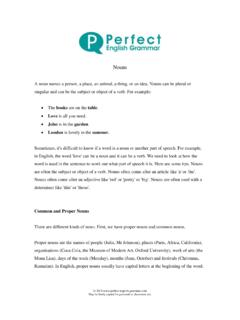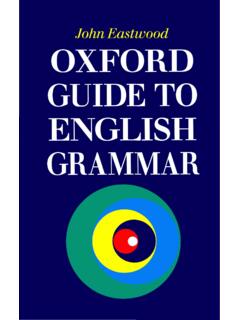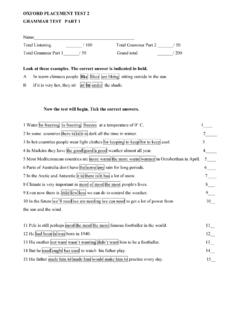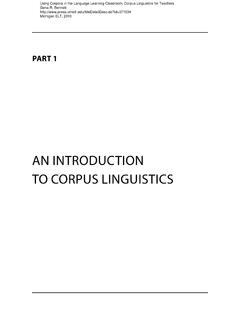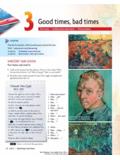Transcription of Canadian Press Style Guide - David McKie
1 Canadian Press Style Guide An Overview The Canadian Press Stylebook is the standard for most universities and colleges in the country, but it also goes through regular revisions. The current edition is the thirteenth. Titles should be used with given name and surname on first reference, and long titles should be offset in apposition. You should only use titles rarely after the first use (this is not always true for the university environment): Dean John Michaels was in attendance. Jane Rutherford, Acting Dean of Pharmacy, attended the meeting. In general, do not use the courtesy titles Mr., Mrs., Ms or Miss. When possible, refer to a married couple by their first names and then their last name; when they do not share the same last name, an explanation is necessary.
2 Jane Smith and Erin Michaels, a married couple, do not share a surname. Jason and Erin Lee do. According to CP Style , the professional title Dr. is only used for licensed health care professionals, such as dentists, veterinarians, and chiropractors (note that this can conflict with the university environment and the University s Style Guide ). Currently, the title is followed by a period, though this is not typically the case in many newspapers and some universities or the older editions of the CP Stylebook): Dr. Jane Smith, a chiropractor, addressed the audience. Jack Turner, a doctor of philosophy, delivered his presentation to his peers. In CP Style , capitalize the names of universities but not their departments (this conflicts with much standard practice), and use lowercase for schools: The University of Alberta s department of economics has received national accolades.
3 The faculty of arts is among the largest in Canada, and the department of english is particularly well-known. Both encourage the Victoria high school s growth. Spell out numbers under ten, and use figures for those 10 and above. Do not use commas to separate different units of the type of measure. Spell out first through ninth and use figures for higher enumerations: We had three batteries, nine minutes 30 seconds of preparation time, 12 rolls of wire, nine light bulbs, and 30 inches of solder, but not even one solder iron. Other rules for numbers: For numbers at the beginning of a sentence, always spell the number Use Roman numerals only for sequences of people or animals, such as in a lineage Do not list decades or centuries in the possessive form (ie: 1920s not 1920 s) For possessives, use an apostrophe s for all words not ending in s.
4 For those that end in an s, plural words are followed by an apostrophe alone while singular words are followed by an apostrophe s, unless it would be distracting to speak it aloud with the extra syllable, in which case use only an apostrophe: The faculty of engineering raised the instructors salary. (plural possessive) Professor Jones s class was unruly. (singular possessive. Alternatively: Professors Jones ) Joint possessives use only one apostrophe. Individual possessives require two: Jane Jones and Frank Phung s proposal was unanimously accepted. (joint possessive) We are interested in two of the proposals coming from faculty members in the department of genetics: Dr. Johnson s and Monica Engstrom s. CP Style uses the oxford english Dictionary as its authoritative Guide for spelling.
5 Where alternative spellings are listed, use the first. For abbreviations, omit periods unless the abbreviation is geographical. For degrees, most lowercase and mixed abbreviations take periods unless they begin and end with a capital letter. Dr. Smithe was present when Ben Nielsen was awarded his PhD, but he did miss the convocation for Nielsen s two years earlier. Dates and times are not abbreviated, but months may be abbreviated when they follow a specific date. January 2005 was particularly cold, but on Mar. 5, 2005, this all changed. Chapter 19 Canadian Press Style Whether or not you have noticed, you have certainly read a Canadian Press news story. Open any Canadian newspaper and you will see many stories that start with the initials CP. These are stories distributed by the Canadian Press . Even if you ve somehow avoided newspapers entirely, you probably still haven t escaped CP which has a broadcasting arm that produces news and clips for radio stations called Broadcast News, or BN.
6 The Canadian Press is a newsgathering co-operative financed by Canada s daily newspaper industry. It s had its high points and its low points, but since it was founded in 1917 it has served Canadian newspapers, and Canadian newspaper readers, well. CP is a wire service, a term that once sounded modern and now sounds rather quaint. It is used to describe a service that distributes news coverage by wire or, nowadays, via the Internet. The idea behind a wire service is that every newspaper in the world can t afford to have a reporter in every place in the world. But every newspaper can subscribe to a wire service instead, and run news gathered in faraway places by wire service contributors. Some wire services like Reuters of the United Kingdom and Bloomberg News Service of the United States are straight commercial operations that hire reporters and get stories from their bureaus around the globe.
7 More often though, wire services are co-operatives like the Canadian Press in Canada, the Associated Press in the United States and the Press Trust in Britain owned and operated by the newspapers of the country. That way, a story from the Chronicle-Herald in Halifax can be distributed for use by the Victoria Times-Colonist, and a story from the Saskatoon Star Phoenix can be used by the Toronto Globe and Mail, and so on. So the Canadian Press , with bureaus in major cities throughout Canada, can edit and distribute stories from all its member newspapers for use by all its other papers eliminating the need for member papers to run expensive bureaus of their own in far-flung places. In addition to editors in its bureaus, CP also employs its own journalists in a few major centres to cover and write important stories. The embarrassing little secret of Canadian newspapers is that CP s reports are usually better than the stories written by papers own reporters clearer, more accurate, with better leads.
8 Young reporters could do far worse than to emulate stories edited and written by the Canadian Press . If you plan to pursue a career in journalism, the Canadian Press Stylebook and CP s Caps and Spelling are essential tools. (The latter is a smaller publication that lists words, proper names and abbreviations that frequently cause problems for writers and editors.) Even if you don t, the good news is that they are both more likely to be more valuable additions to your bookshelf than most college textbooks. (The bad news is that CP Style , while religiously consistent with itself, is often illogical. Why are geographical abbreviations , always shown with periods, and non-geographical abbreviations RCMP, NATO written without? It s not logical, but it is the way it is. Memorize the difference!) They are essential tools because most Canadian newspapers follow CP Style .
9 That is, virtually all of them produce stories in which numbers, addresses, geographical names, dollar amounts, temperatures and dates are written in a uniform format. Consider the simple question of percentages: are they shown as percent, per cent or %? (The Canadian Press Stylebook says per cent. The Associated Press Stylebook says percent. ) The advantage of this is obvious when stories are being shared among a large number of newspapers. (The difficulty of keeping copy consistent is obvious too just look at the number of editors CP must employ in its bureaus!) The reality for students of journalism in Canada is that they need to know the key points of CP Style . Indeed, it s a good idea to start writing all your stories in CP Style right now. Check the Stylebook when you must be certain about an obscure point, but you need to keep the commonly areas that are listed below in your head.
10 If you do, and your copy reflects your knowledge, you are more likely to be seen as a professional from the day you walk into the newsroom. There s an old CP proverb, much quoted by journalists: When in doubt, leave it out. But if you encounter a question of Style , and you ve not memorized it form the cheat sheet below, the real proverb is this: When in doubt, look it up in the Stylebook! Essential Points of CP Style Numbers The greatest, or at least the most commonly occurring, inconsistency in Canadian Press Style is in its treatment of numbers, which naturally crop up in a wide variety of typical instances. In general, CP Style requires you to spell out whole numbers below 10 and use figures for 10 and above. When they are in a series, there will often be a mixture. There were three Fords, two Chevrolets, 15 Volkswagens, 22 Chryslers and one Humber on the car lot, of which 30 had four-cylinder engines, 10 were sixes and three were eights.


